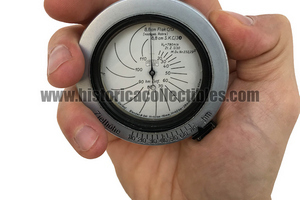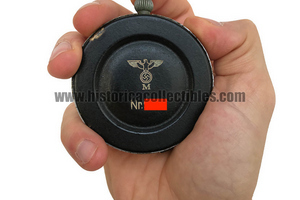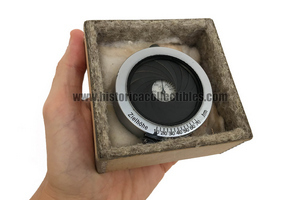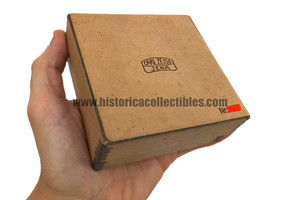Carl Zeiss Compteur Flak-Artillerie-Stoppuhr, Reichs-Kriegsmarine, 1916/1935
Stoppuhr (Stopwatch Chronograph) made by Minerva and commissioned by Carl Zeiss, which on June 20, 1916, deposited the patent of the dial as well as the appropriate mechanical device with aperture of the diaphragm.
Given the exponential development of Military Aviation and the increasingly pressing demand of the belligerent nations to stem the problem of enemy bombings rewriting the boundary boundaries dictated by trenches, in 1916, Zeiss commissioned at Minerva the realization of a "Stopwatches Chronograph" for the calculation of the "Time/Distance" equation, measured on a "hm" scale and used to calibrate the explosion mechanism of the 8.8 cm caliber bullets used by Flak, depending on the height and flight paths of enemy planes.
Made by Minerva, this Chronometer with Complications, designed for the 12-second computation (to date, is the only known in this version) and is part of the first batch of production specially designed for Zeiss in 1916. Subsequently, the Zeiss replaced the original quadrant designed for Flak's 8.8 cm caliber gun during the First World War, and produced a dial and a mechanical device that took into account the characteristics of 2 models of anti Aircraft and Ships Cannons, from 1933: 8.8 cm Flak C/13 "Nachgebohrte Rohre" (Fliegerabwehrkanone - used from 1933 to 1945 and used, in addition to Flak, also against Tanks) and SKC/30 (SK - Schnelladekanone, Rapid Fire Cannon, C - Construktionsjahr, year of design), in use from 1933 to 1945 and installed on Hunting Submarines and Corvette supplied with Flak and U-Boot.
Fully functional in every mechanism and complete with the original box.
The only known specimen with these features.
ZEISS PATENT:
to the Imperial Patent Office, registration office for utility models
Berlin SW 61
The undersigned company, after having paid the statutory fee of 15 M to the cashier of the Imperial Patent Office today by postal order, hereby deposits - with the application for suspension of the registration for a period of 6 months because there is a military interest in the temporary confidentiality could- the attached drawing and the following protection claim for one
USE PATTERNS
under this name:
"Clock"
Right to protection
Clock whose dial is equipped with a plurality of curves, each of which is a curve of equal values of a variable (in the example shown, the speed of an airplane), the size of which depends on the time traversed by the clock hand from its zero position and on its size according to another variable (in the example shown, the flight altitude) corresponding distances of the currently considered point of the pointer (a) from the center of the dial results, characterized by an iris diaphragm (b), which serves with its edge to the respective point under consideration to designate the distance to be drawn, uncharacterized by a scale (c) which is numbered according to the second variable and with which a pointer (d) belonging to the adjusting device of the iris end interacts in such a way that the value of the second variable is displayed on it corresponds to the current diameter of the iris diaphragm.
Carl Zeiss takes its name from its founder, Carl Zeiss, who on November 17, 1846 chose the small town of Jena, in Thuringia, as the location for his precision optical equipment factory. Thanks to the severe quality control that Carl Zeiss imposed on his products, going so far as to personally destroy the microscopes that did not pass the tests, the newly formed Zeiss became the official supplier of the University of Jena and received the gold medal of the industrial exhibition in 1861 of Thuringia as the best research instrument produced in Germany, awarded to the Stand I microscope of 1857.
In 1866 the thousandth microscope was produced and the name Zeiss became known throughout European scientific circles. Thanks to studies on the Porro prism, in 1893 Abbe patented double prism binoculars, which accentuated the perception of depth. The mass production of Zeiss binoculars began in 1894, already at the beginning of the twentieth century more than 30,000 were made, at the beginning of the First World War the quota had risen to 500,000 and, at the end of the Second World War, as many as 2,260,000 were produced binoculars for the civil and military market.
Models were made starting from 4x11 mm to 12x40 mm, up to real giants such as the 80 mm and 100 mm. Thanks to studies conducted on the perception of light in low light situations, it was demonstrated that the average dilation of the pupil in an adult is approximately 7 mm. For this reason, the 7x50 mm model was introduced in 1910 and remained on the market until 1917 with few changes to the materials used. In 1926, following the post-war crisis of the First World War with the Treaty of Versailles which bankrupted many important German companies, Zeiss purchased "C.P. GOERZ" and founded Zeiss Ikon in 1926.
In 1937 Zeiss had commercial contacts and factories in more than 29 countries around the world. From '33 Zeiss acquired interest from the Nazi regime, which balanced production towards military instruments. It successfully produced binoculars with wide-angle optics for military use, pressure-resistant optical systems for U-boats, periscope binoculars for targeting tanks. Furthermore, Zeiss cameras were mounted on the V2s for remote sensing operations of the English coasts.
On 1 November 1935, Zeiss, in the figure of Alexander Smakula, patented a process for the treatment of optical glass with extraordinary results in terms of light transmission. Remained a military secret until 1939, it was adopted on binoculars to reduce ghost images and internal reflections. During the Second World War, there were numerous bombings against the Zeiss factories. Jena was bombed several times by the Allies starting in 1944.
Stuttgart was razed to the ground, although the Contessa-Nettel factory suffered little damage. The bombing of Dresden, in addition to devastating the city, also caused considerable damage to the Zeiss Ikon headquarters.
On April 13, 1945, American military forces entered Jena, surprising themselves that the bombing had not caused any significant damage. The main planetarium was in ruins, while the factories remained operational.
Minerva:
Caliber 19''' no.14 first series produced in November 1911 starting with number 934707 and designed around the pocket caliber no.9 of April 1908.
Founded in 1858 by the brothers Charles-Yvan (1840-1912) and Hyppolite Robert of Villeret, what would later become the Minerva watch brand was initially a watch "etablisseurs", that is to say a company assembling parts of watches produced by the Fontanemelon ebauches factory (FHF). An old business letter indicates that the company was called H. & C. Robert S.A, in Villeret.
In 1878, Charles-Yvan's sons, Charles-Auguste and Georges-Louis Robert continued the business in the footsteps of the founders; in 1885 the third brother, Yvan, also joined the company.
In 1887 the symbol of the Manufacture, in the shape of a V, an arrow separating the letters R, F and V (Robert Frères Villeret) was officially patented.
It is interesting to note that the name of the deity Minerva was first used only as a trademark, officially registered on 30.7.1887, together with other sonorous names such as “Arianna” and “Mercury”.
The company developed slowly but steadily; he participated in the Universal Expositions of Antwerp (1885) and Paris (1889), where he earned recognition for his products.
The company name has changed several times, starting as “Fabrique Robert Freres” in 4.2.1898 when the two sons succeeded their father, then “Faquique des Faverges, Robert Freres” in 1902, then “Fabrique Minerva, Robert Freres S.A. in 1923 and finally, in 1929, “Minerva” S.A.
In 1902, under their direction, two wings were added to the historic headquarters of 1845, rebuilt after a fire in 1875, to house a watchmaking laboratory and a workshop with machine tools that manufactured movements and cases in nickel and silver for pocket watches: Minerva thus transformed into a watch "manufacturing".
At the beginning of the century the manufacture began to produce pocket watch movements with the following calibres, in which the first number of the acronym indicates the diameter in French lines (“'); the second is the progressive serial number of the manufacturing movements:
– CALIBER n° 1-18, with 18-line MOVEMENT with cylinder ESCAPEMENT, which remained in production, with small changes, until 1941;
– CALIBER n° 2, with 18 or 19 ligne MOVEMENT with a Swiss ANCHOR escapement;
– CALIBER n° 3, MOVEMENT with 19 lines.
These watches, like those of the following years 17-15, 17-22, 17-23, were equipped with 17 jewels with screwed bezels, with 5 adjustments (3 positions and 2 temperatures), cut BIMETAL BALANCE, Breguet SPIRAL, and REGULATION end of the RACKET with gooseneck retention spring or eccentric screw (the Cal.19-4), partially finished with “cotes de Geneve”.
In 1908 the Manufacture began the production of its first CHRONOGRAPH with the CALIBER 19-9 CH; like the chronographs of subsequent years, it did not have a chronograph hour adder, but only a minute register based on 30 or 45.
In those years, the fact that the supply catalog shows calibers from 12 to 16 Size, therefore indicating the American sizes, demonstrates the great importance exports to America had for the company at the time.
The precise years in which wristwatch production began is not known. The older calibers are the 12-12 and the 9 ¾ -19, with refined movements, 17 jewels, Breguet SPIRAL and 4 mm thick. The CASE number of these watches dates them back to 1918.
The 9 ¾-9 calibers were, however, the smallest calibers ever built by Minerva.
In 1923, the name “Minerva” appeared on watch dials; as already mentioned, the company was subsequently renamed “Fabrique Minerva, Robert Frères S.A.” when the production of wristwatches began.
One of these was the refined CALIBER 13-20 CH, a CHRONOMETER with 12 ¾ ligne MOVEMENT that appeared on the market in 1923, a CALIBER that perfectly illustrates the classic and refined architecture of wrist chronographs of that era, with a wheel MECHANISM column, Breguet BALANCE SPIRAL and 17 jewels.
With the launch of this watch, the company earned its reputation as a supplier of complicated movements of exceptional quality.
At the beginning of the 1930s the international financial crisis forced the Robert family to abandon the business; an engineer specialized in watch mechanics, Jacques Pelot, from Biel, who had worked at Minerva since 1921, and a technician Charles Haussener successfully became managers of the Manufacture. This is also demonstrated by the assignment received, in 1936, as Official Timekeeper of the race times at the Garmisch – Partenkirchen Winter Olympics.





